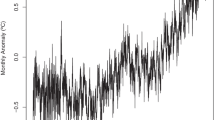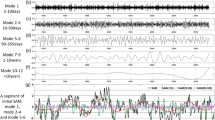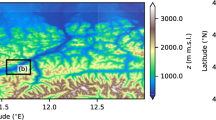Abstract
A methodology based on Empirical mode decomposition (EMD) was used to filter out non-turbulent motions from measurements of atmospheric turbulence over the sea, aimed at reducing their contribution to eddy-covariance (EC) estimates of turbulent fluxes. The proposed methodology has two main objectives: (1) to provide more robust estimates of the fluxes of momentum, heat and CO\(_2\); and (2) to reduce the number of flux intervals rejected due to non-stationarity criteria when using traditional EC data processing techniques. The method was applied to measurements from a 28-day cruise (HALOCAST 2010) in the Eastern Pacific region. Empirical mode decomposition was applied to 4-h long time series data and used to determine the cospectral gap time scale, \(T_\mathrm{{gap}}\). Intrinsic modes of oscillation with characteristic periods longer than the gap scale due to non-turbulent motions were assumed and filtered out. Turbulent fluxes were then calculated for sub-intervals of length \(T_\mathrm{{gap}}\) from the filtered 4-h time series. In the HALOCAST data, the gap scale was successfully identified in 89% of the 4-h periods and had a mean of 37 s. The EMD approach resulted in the rejection of 11% of the flux intervals, which was much less than the 68% rejected when using standard filtering methods based on data non-stationarity. For momentum and sensible heat fluxes, the averaged difference in flux magnitude between the traditional and EMD approaches was small (3 and 1%, respectively). For the CO\(_2\) flux, the magnitude of EMD flux estimates was on average 16% less than fluxes estimated from linear detrended 10-min time series. These results provide evidence that the EMD method can be used to reduce the effects of non-turbulent correlations from flux estimates.












Similar content being viewed by others
References
Acevedo OC, Moraes OL, Degrazia GA, Medeiros LE (2006) Intermittency and the exchange of scalars in the nocturnal surface layer. Boundary-Layer Meteorol 119(1):41–55
Aubinet M (2008) Eddy covariance CO\(_2\) flux measurements in nocturnal conditions: an analysis of the problem. Ecol Appl 18(6):1368–1378
Aubinet M, Vesala T, Papale D (2012) Eddy covariance: a practical guide to measurement and data analysis. Springer, Dordrecht, 438 pp
Barnhart B, Eichinger W, Prueger J (2012) A new eddy-covariance method using empirical mode decomposition. Boundary-Layer Meteorol 145(2):369–382
Blomquist BW, Huebert BJ, Fairall CW, Bariteau L, Edson JB, Hare JE, McGillis WR (2014) Advances in air–sea CO\(_2\) flux measurement by eddy correlation. Boundary-Layer Meteorol 152(3):245–276
Campos JG, Acevedo OC, Tota J, Manzi AO (2009) On the temporal scale of the turbulent exchange of carbon dioxide and energy above a tropical rain forest in Amazonia. J Geophys Res Atmos. doi:10.1029/2008JD011240
Colominas MA, Schlotthauer G, Torres ME (2014) Improved complete ensemble EMD: a suitable tool for biomedical signal processing. Biomed Signal Process 14:19–29
Edson J, Hinton A, Prada K, Hare J, Fairall C (1998) Direct covariance flux estimates from mobile platforms at sea. J Atmos Ocean Technol 15(2):547–562
Edson JB, Jampana V, Weller RA, Bigorre SP, Plueddemann AJ, Fairall CW, Miller SD, Mahrt L, Vickers D, Hersbach H (2014) On the exchange of momentum over the open ocean. J Phys Oceanogr 44(9):1589
Hu L, Yvon-Lewis S, Liu Y, Bianchi TS (2012) The ocean in near equilibrium with atmospheric methyl bromide. Global Biogeochem Cycles. doi:10.1029/2011GB004272.1
Huang NE, Wu Z (2008) A review on Hilbert–Huang transform: Method and its applications to geophysical studies. Rev Geophys. doi:10.1029/2007RG000228
Huang NE, Shen Z, Long SR, Wu MC, Shih HH, Zheng Q, Yen NC, Tung CC, Liu HH (1998) The empirical mode decomposition and the Hilbert spectrum for nonlinear and non-stationary time series analysis. Proc R Soc Lond A 454(1971):903–995
Huang NE, Shen Z, Long SR (1999) A new view of nonlinear water waves: the hilbert spectrum. Annu Rev Fluid Mech 31(1):417–457
Huang NE, Wu MLC, Long SR, Shen SS, Qu W, Gloersen P, Fan KL (2003) A confidence limit for the empirical mode decomposition and Hilbert spectral analysis. Proc R Soc Lond A 459(2037):2317–2345
Kaimal JC, Finningan JJ (1994) Atmospheric boundary layer flows. Oxford University Press, Oxford, 289 pp
Lilly DK (1968) Models of cloud-topped mixed layers under a strong inversion. Q J R Meteorol Soc 94(401):292–309
Mahrt L (2010) Computing turbulent fluxes near the surface: needed improvements. Agric For Meteorol 150(4):501–509
Mallat SG (1989) A theory for multiresolution signal decomposition: the wavelet representation. IEEE Trans Pattern Anal Mach Intell 11(7):674–693
Marandino C, De Bruyn W, Miller S, Saltzman E (2007) Eddy correlation measurements of the air/sea flux of dimethylsulfide over the North Pacific Ocean. J Geophys Res Atmos. doi:10.1029/2006JD007293
McGillis WR, Edson JB, Ware JD, Dacey JW, Hare JE, Fairall CW, Wanninkhof R (2001) Carbon dioxide flux techniques performed during GasEx-98. Mar Chem 75(4):267–280
Metzger M, Holmes H (2008) Time scales in the unstable atmospheric surface layer. Boundary-Layer Meteorol 126(1):29–50
Miller SD, Goulden ML, Menton MC, da Rocha HR, de Freitas HC, Figueira AMeS, Dias de Sousa CA (2004) Biometric and micrometeorological measurements of tropical forest carbon balance. Ecol Appl 14(sp4):114–126
Miller S, Hristov T, Edson J, Friehe C (2008) Platform motion effects on measurements of turbulence and air–sea exchange over the open ocean. J Atmos OceanTechnol 25(9):1683–1694
Miller SD, Marandino C, Saltzman ES (2010) Ship-based measurement of air–sea CO\(_2\) exchange by Eddy Covariance. J Geophys Res Atmos. doi:10.1029/2009JD012193
Moncrieff J, Clement R, Finnigan J, Meyers T (2004) Averaging, detrending, and filtering of eddy covariance time series. In: Handbook of micrometeorology. Springer, Berlin, pp 7–31
Oncley SP, Friehe CA, Larue JC, Businger JA, Itsweire EC, Chang SS (1996) Surface-layer fluxes, profiles, and turbulence measurements over uniform terrain under near-neutral conditions. J Atmos Sci 53(7):1029–1044
Sakai RK, Fitzjarrald DR, Moore KE (2001) Importance of low-frequency contributions to eddy fluxes observed over rough surfaces. J Appl Meteorol 40(12):2178–2192
Vickers D, Mahrt L (2003) The cospectral gap and turbulent flux calculations. J Atmos Ocean Technol 20(5):660–672
Vickers D, Mahrt L (2006) A solution for flux contamination by mesoscale motions with very weak turbulence. Boundary-Layer Meteorol 118(3):431–447
Wang J, Song J, Huang Y, Fan C (2013) Application of the Hilbert–Huang transform to the estimation of air-sea turbulent fluxes. Boundary-Layer Meteorol 147(3):553–568
Wu Z, Huang NE (2009) Ensemble empirical mode decomposition: a noise-assisted data analysis method. Adv Adapt Data Anal 1(01):1–41
Wu Z, Huang NE, Long SR, Peng CK (2007) On the trend, detrending, and variability of nonlinear and nonstationary time series. Proc Natl Acad Sci 104(38):14,889–14,894
Xu Y, Chen J (2004) Characterizing nonstationary wind speed using empirical mode decomposition. J Struct Eng ASCE 130(6):912–920
Yeh JR, Shieh JS, Huang NE (2010) Complementary ensemble empirical mode decomposition: a novel noise enhanced data analysis method. Adv Adapt Data Anal 2(02):135–156
Yelland M, Moat B, Pascal R, Berry D (2002) Cfd model estimates of the airflow distortion over research ships and the impact on momentum flux measurements. J Atmos OceanTechnol 19(10):1477–1499
Acknowledgments
Participation in the HaloCAST cruise was supported by US National Science Foundation award ATM 0851407. LGM and OCA were supported in Brazil by CAPES (Coordenação de Aperfeiçoamento de Pessoal de Ensino Superior), CNPq (Conselho Nacional de Desenvolvimento Científico e Tecnológico) and FAPERGS (Fundação de Amparo à Pesquisa do Estado do Rio Grande do Sul).
Author information
Authors and Affiliations
Corresponding author
Rights and permissions
About this article
Cite this article
Martins, L.G.N., Miller, S.D. & Acevedo, O.C. Using Empirical Mode Decomposition to Filter Out Non-turbulent Contributions to Air–Sea Fluxes. Boundary-Layer Meteorol 163, 123–141 (2017). https://doi.org/10.1007/s10546-016-0215-0
Received:
Accepted:
Published:
Issue Date:
DOI: https://doi.org/10.1007/s10546-016-0215-0




